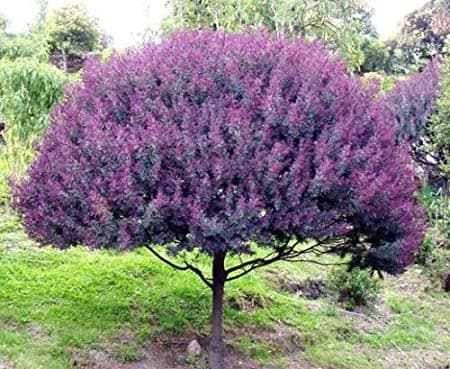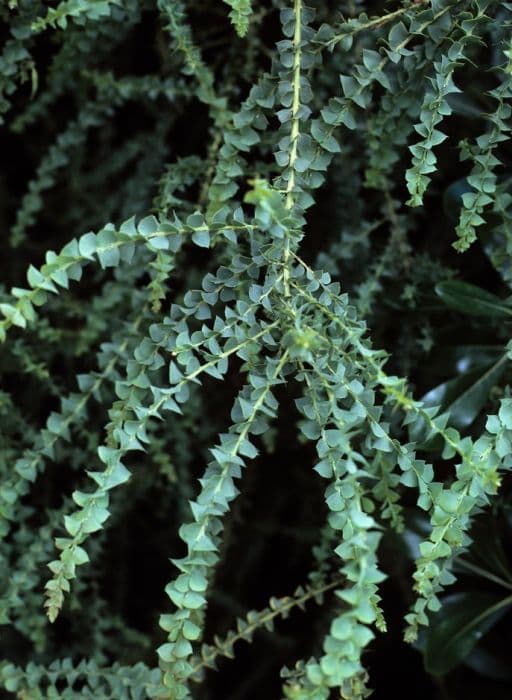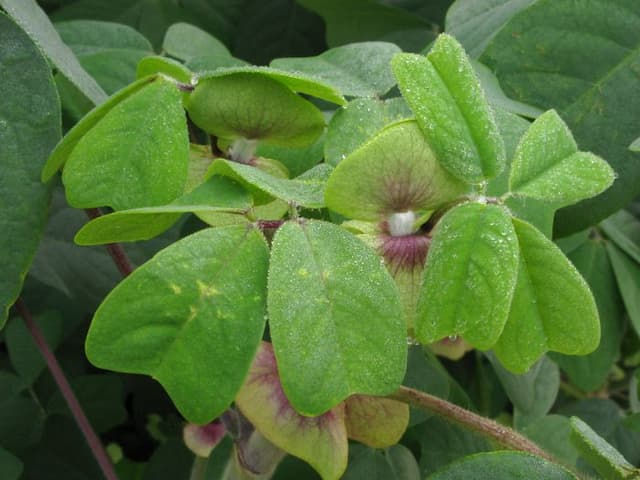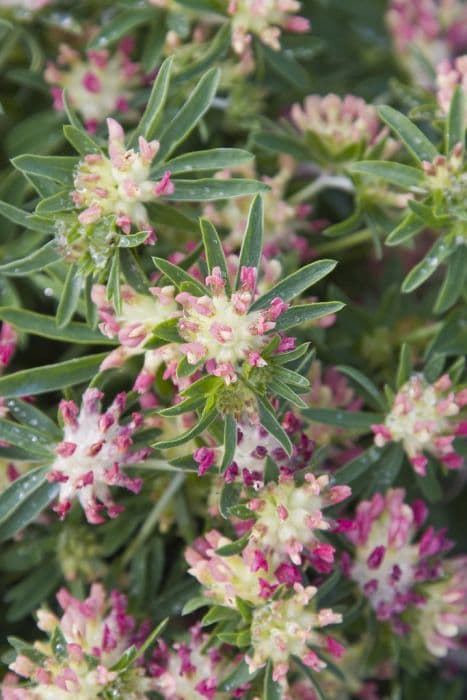Cancer Bush Sutherlandia frutescens

ABOUT
The plant known commonly as cancer bush is a visually striking shrub that possesses a fine balance between lushness and hardiness. This well-known plant carries itself with a somewhat sparse and open habit, revealing gray-green, pinnately divided foliage that conveys an airy texture. The small leaves are often complemented by pea-like flowers that exhibit a vibrant display of colors, ranging from red to orange and occasionally yellow. The blossoms, emerging on the tips of the branches, capture attention and create a warm, inviting palette. As the growing season progresses, the cancer bush may produce inflated, bladder-like pods that add yet another element of visual interest. These pods are typically green, gradually transitioning to a papery brown texture as they mature. The overall impression of the cancer bush is of a robust, resilient plant capable of providing a burst of color and a sense of agility in its movement and overall form. It carries an aura of the rustic and the untamed, exuding a natural charm that is both distinctive and appealing.
About this plant
 Names
NamesFamily
Fabaceae.
Synonyms
Balloon Pea, Cancer Bush, Cancer Bush Pea, Kankerbossie, Phetola, Unwele.
Common names
Colutea frutescens, Lessertia frutescens.
 Toxicity
ToxicityTo humans
The Sutherlandia frutescens, commonly known as cancer bush, is not widely recognized as poisonous to humans. While it has been used traditionally in South African medicine for various ailments, its safety profile has not been fully evaluated scientifically. Limited clinical evidence suggests that cancer bush may have some side effects if not used appropriately, such as dry mouth, mild diarrhea, or dizziness, but the toxicity and potential for serious poisoning are not well-documented. Prolonged or inappropriate use may have unknown consequences, so it should be approached with caution and under professional guidance.
To pets
The toxicity of cancer bush (Sutherlandia frutescens) to pets such as cats and dogs is not well-documented. There is limited information available about its effects on animals, but given the lack of evidence regarding its safety, it is prudent to prevent pets from ingesting this plant. If a pet does consume cancer bush, watch for signs of gastrointestinal upset or unusual behavior, and consult a veterinarian. As with any non-food plant, it is generally advisable to keep it out of reach of pets to avoid any potential risks.
 Characteristics
CharacteristicsLife cycle
Perennials
Foliage type
Deciduous
Color of leaves
Green
Flower color
Red
Height
3 feet (0.9 meters)
Spread
3 feet (0.9 meters)
Plant type
Shrub
Hardiness zones
9
Native area
South Africa
Benefits
 General Benefits
General Benefits- Cultural Symbolism: In its native regions, the plant, commonly known as 'Cancer Bush,' often holds cultural significance and is used in traditional ceremonies and rituals.
- Drought Resistance: Cancer Bush is known for its high drought tolerance, making it suitable for xeriscaping and water-efficient gardens.
- Ornamental Uses: With its bright red or orange flowers, Cancer Bush is often grown for decorative purposes to enhance the aesthetics of gardens and landscapes.
- Wildlife Attraction: The nectar-rich flowers attract beneficial pollinators, such as bees and birds, contributing to the pollination of plants and the health of ecosystems.
- Soil Erosion Control: Cancer Bush can be used in landscaping to stabilize soil and prevent erosion due to its hardy nature and root system.
- Adaptability: It is adaptable to a variety of soil types, which allows it to thrive in a range of environments outside its native habitat.
- Fast Growth: Cancer Bush tends to grow relatively quickly, offering a swift solution for areas needing ground coverage or enhancement.
- Minimal Maintenance: The plant generally requires minimal care once established, making it a practical choice for low-maintenance gardens.
- Culinary Use: Although not distinguished for its culinary uses, some parts of the plant have been used in traditional recipes in its native range.
 Medical Properties
Medical Properties- Immune System Support: Sutherlandia frutescens is traditionally believed to bolster the immune system, providing general immune support.
- Anti-inflammatory: The plant possesses anti-inflammatory properties which can help in reducing inflammation.
- Antioxidant: It contains compounds that exhibit antioxidant effects, which can help in protecting the body from oxidative stress.
- Anticancer Properties: Some studies suggest that it may possess anticancer properties, though further research is needed to substantiate these claims.
- Anti-HIV Activity: There are indications that Sutherlandia frutescens might exhibit anti-HIV activity, but more scientific validation is required.
- Treatment of Anxiety and Depression: It is sometimes used in traditional medicine to help treat symptoms of anxiety and depression.
- Appetite Stimulant: The plant has been used traditionally to stimulate appetite, especially in individuals suffering from wasting illnesses.
- Diabetes Management: There is some evidence to suggest that it may help in the management of diabetes, although conclusive clinical data is lacking.
 Air-purifying Qualities
Air-purifying QualitiesThis plant is not specifically known for air purifying qualities.
 Other Uses
Other Uses- Sutherlandia frutescens, commonly known as the cancer bush, has been used as a natural detergent. The plant's leaves can be crushed and mixed with water to create a soapy lather for cleaning.
- The fine fibers from the bark of cancer bush can be used for making strong cords and ropes, providing a natural solution for crafters and traditional artisans.
- Due to its dense and bushy growth, cancer bush can serve as a protective hedge or living fence in gardens, offering both privacy and shelter from the wind.
- The leaves of cancer bush emit a strong odor that can act as a natural insect repellent, helping to keep pests at bay without the use of chemicals.
- The woody stems of cancer bush can be utilized as kindling for fires, aiding in quick and easy ignition due to its dry and flammable nature.
- The attractive red-orange flowers of cancer bush can be used in decorative arrangements, adding a pop of color to bouquets or as garnishes in culinary presentations.
- Cancer bush has traditionally been used in storytelling and cultural rituals by various indigenous groups, being incorporated as a symbol of healing and protection.
- The plant's ability to grow in poor soil conditions makes cancer bush useful for soil erosion control, helping to stabilize the soil and prevent degradation.
- Cancer bush can be planted as part of a xeriscape garden, which requires minimal irrigation, making it an eco-friendly choice for water conservation landscaping.
- The seeds of cancer bush can be used as a substitute for peas in certain traditional games and handicrafts, providing an alternative when more conventional materials are not available.
Interesting Facts
 Feng Shui
Feng ShuiThe Cancer Bush is not used in Feng Shui practice.
 Zodiac Sign Compitability
Zodiac Sign CompitabilityThe Cancer Bush is not used in astrology practice.
 Plant Symbolism
Plant Symbolism- Protection: Sutherlandia frutescens, also known as Cancer Bush, is believed to protect against illnesses and evil spirits due to its historical use as a medicinal plant.
- Healing: The Cancer Bush is often associated with healing because of its use in traditional medicine to treat a variety of ailments, symbolizing the body's ability to recover.
- Strength and Resilience: Given its name and robust nature, the Cancer Bush symbolizes strength and the ability to withstand harsh conditions, both physically and emotionally.
- Hope: As a plant used to potentially alleviate the symptoms of serious diseases, the Cancer Bush represents hope for health and well-being.
 Water
WaterThe Cancer Bush should be watered deeply but infrequently, as it is drought tolerant once established. During the growing season, water approximately once a week with about 1 to 1.5 gallons, allowing the soil to dry out between watering sessions to prevent root rot. In the winter, reduce watering to every two to three weeks, depending on the humidity and temperature. Always adjust the watering frequency based on the plant's appearance and the weather conditions, as overwatering can be detrimental.
 Light
LightCancer Bush thrives in full sunlight, meaning it prefers a spot that receives at least six to eight hours of direct sunlight daily. However, it can tolerate partial shade, especially in hotter climates. Ensure the plant is placed in a location where it can receive ample sunlight throughout the day for optimal growth and flowering.
 Temperature
TemperatureCancer Bush prefers warm temperatures and can tolerate a range from about 50°F to 104°F. However, the ideal temperature for this plant is between 70°F and 85°F. It is not frost-hardy, so it should be protected or brought indoors if temperatures are expected to fall below the minimum threshold.
 Pruning
PruningPruning Cancer Bush is important to maintain its shape and encourage bushier growth. Prune in the late winter or early spring before new growth begins. Remove dead or weak stems, and cut back about one-third of the plant to promote new growth and flower production. Prune the plant every year or as needed to keep it looking its best.
 Cleaning
CleaningAs needed
 Soil
SoilCancer Bush prefers well-drained soil enriched with organic matter, such as compost, and a pH of 6.5 to 7.5. A mix with equal parts of loam, peat moss, and coarse sand is ideal for proper drainage and root development.
 Repotting
RepottingCancer Bush should be repotted every 2-3 years to refresh the soil and to accommodate root growth. Ensure pots provide adequate drainage.
 Humidity & Misting
Humidity & MistingCancer Bush is tolerant of dry air but prefers moderate humidity levels. Aim to maintain humidity around 40-50% for optimal growth.
 Suitable locations
Suitable locationsIndoor
Provide bright light, good air circulation, and occasional watering.
Outdoor
Plant in full sun to partial shade with well-draining soil.
Hardiness zone
9-11 USDA
 Life cycle
Life cycleSutherlandia frutescens, commonly known as the cancer bush, initiates its life cycle from a seed, which germinates in early spring or after the fall of rain. Seedlings emerge and establish themselves, growing into bushy plants that can reach up to 1 meter in height. The leaves form in pairs along the stems, and the distinctive bright red or orange pea-like flowers bloom from September to December. After pollination, typically by insects, the plant produces inflated, bladder-like pods that contain the seeds. These pods eventually dry out and open, releasing seeds for the next generation. Cancer bush is a perennial plant, meaning it can survive for several years, undergoing periods of dormancy during drought and regrowing when conditions are favorable.
 Propogation
PropogationPropogation time
Spring to Summer
Sutherlandia frutescens, also known as cancer bush, is commonly propagated by seeds. The best time for seed propagation is in the spring after the danger of frost has passed. To propagate cancer bush by seeds, first, seeds should be sown in a well-drained medium such as sandy soil. It's advisable to lightly cover the seeds with the same growing medium to a depth approximately equivalent to the thickness of the seed. Water gently and keep the soil moist but not overly wet. Seeds should germinate within two weeks, and once the seedlings are robust enough to handle, they can be transplanted into individual pots or into their final location in the garden. It's important to ensure that the young plants have adequate space for growth and are placed in an area that receives sufficient sunlight.









